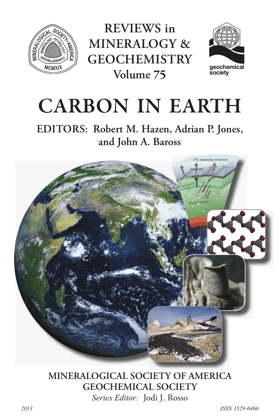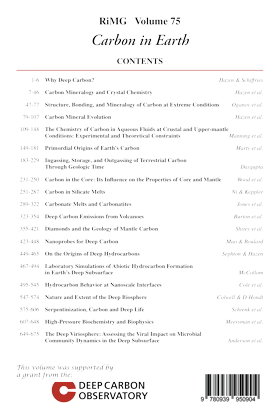Robert M. Hazen, Adrian P. Jones, and John A. Baross, editors
i-xv + 698 pages. ISBN 978-0-939950-90-4




i-xv + 698 pages. ISBN 978-0-939950-90-4
Description
Carbon in Earth is an outgrowth of the Deep Carbon Observatory (DCO), a 10-year international research effort dedicated to achieving transformational understanding of the chemical and biological roles of carbon in Earth (http://dco.ciw.edu). Hundreds of researchers from 6 continents, including all 51 coauthors of this volume, are now engaged in the DCO effort. This volume serves as a benchmark for our present understanding of Earth’s carbon – both what we know and what we have yet to learn. Ultimately, the goal is to produce a second, companion volume to mark the progress of this decadal initiative.
This volume addresses a range of questions that were articulated in May 2008 at the First Deep Carbon Cycle Workshop in Washington, DC. At that meeting 110 scientists from a dozen countries set forth the state of knowledge about Earth’s carbon. They also debated the key opportunities and top objectives facing the community. Subsequent deep carbon meetings in Bejing, China (2010), Novosibirsk, Russia (2011), and Washington, DC (2012), as well as more than a dozen smaller workshops, expanded and refined the DCO’s decadal goals. The 20 chapters that follow elaborate on those opportunities and objectives.
A striking characteristic of Carbon in Earth is the multidisciplinary scientific approach necessary to encompass this topic. The following chapters address such diverse aspects as the fundamental physics and chemistry of carbon at extreme conditions, the possible character of deep-Earth carbon-bearing minerals, the geodynamics of Earth’s large-scale fluid fluxes, tectonic implications of diamond inclusions, geosynthesis of organic molecules and the origins of life, the changing carbon cycle through deep time, and the vast subsurface microbial biosphere (including the hidden deep viriosphere). Accordingly, the collective authorship of Carbon in Earth represents laboratory, field, and theoretical researchers from the full range of physical and biological sciences.
A hallmark of the DCO is the desire to implement advanced strategies in communications, data management, engagement, and visualization. Accordingly, this volume incorporates some novel aspects. Thanks to sponsorship by the Alfred P. Sloan Foundation, which continues to provide significant support for the DCO, this is the first of the RiMG series to be published as an Open Access volume.
Robert M. Hazen, Geophysical Laboratory, Carnegie Institution of Washington
Adrian P. Jones, University College London
John A. Baross, University of Washington
March 2013
Table of Contents
Title Page
p. i
Copyright
p. ii
From the Series Editor & Preface
p. iii
Table of Contents
p. v-xiv



























































































































































































































































































































































































































































































































































































































































































































